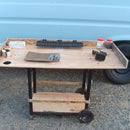Introduction: Tiki Concrete Sculpture
This is often how a sculpture will start out...a simple sketch or two.
I often sketch things and do not return to it for years or even start a project and may not finish for several years due to life's changes and priorities. For example my faux bois handrail project I posted a couple years ago is still unfinished but I use it everyday
https://www.instructables.com/Faux-Bois-Handrail/
This particular project happened very quickly when I finally got to it and did not have in mind doing a step by step, so the steps will include some of the previous handrail steps among other partially finished projects.
Supplies
steel, welder, tools to cut and shape the steel. concrete and various objects to sculpt details, I use forks and wire brushes most often, but also use knives even sticks to accomplish my end result.
Step 1: Finished Tiki
This is the end result, you'll have to imagine the steps used based on other works in progress. I am dismal at documenting my projects unless I start with the intent to do an instructable which I have not done for a few years.
Step 2: Armature
Most sculptures will start with some sort of armature, this is the skeleton of your sculpt whether it be clay or concrete.
This is an additive method of sculpture, like clay where you add material to get to your destination. Stone and wood sculpting is usually subtractive, removing material until you reach your destination.
Armatures can be just about anything that is handy and will support your material of choice, even styrofoam can be used as an armature for concrete, many outdoor rock sculptures start with blocks of styrofoam.
This particular photo shows an armature for my driveway, it is a walking octopus about 4.5 ft tall. It will be holding two jugs of rum with proof numbers reflecting the two addresses as I share a driveway with a neighbor they will be solar lighted as well.
This is the first step to your sculpture, a good sturdy platform on which to work.
Step 3: Metal Lath
I use expanded metal lath to apply the concrete to. This photo is a partially finished section of skirting around my home.and you can see the lath wired to the armature. Tie wire is used for this step and make sure your armature supports the lath with a span of no more than six inches, the concrete is heavy enough to cause the lath to flex and that is very frustrating to work with.
I typically do a single layer of concrete a few inches thick, mixing it to a peanut butter consistency, and sculpting that layer. You could alternatively use a thinner layer of concrete as a primer, letting that dry and stiffen things up, and then coming back with a sculpting layer. Traditional faux bois uses the latter.
I use a product called Tru Pac-X from Walt tools available here: https://www.amazon.com/Tru-Pac-High-Performance-Ve...
This is mixed with Type S Mortar and fine sand, the finer the better not play sand, to make a thick sticky mix. There are a few mortar mixes that have worked well without the additive such as Rapid Set Mortar Mix high strength structural repair mortar.
the concrete mix is applied up to 2-3 inches thick and then allowed to sit for a time, and that varies with temperature and humidity and whether you are inside or outside, so experience will play a part. If you start carving and it crumbles too much wait a bit more and try again, I have waited as much as an hour before carving, just know that once its ready you must work fast so dont apply too much at once. Work in sections applying the mix in small quantities allowing it to set up as you mix and apply the next section. As you carve the first section the next is setting up and ready to go as you get done with the first
The Tiki was such a small project that it was applied all at one allowed to set for a bit while I did other things and then carved all at once.
Details are carved in using forks for wood grain and fur with help from wire and plastic brushes, the choice of sand plays a part in how fine you can get the details, I said above don't use play sand, however if your detail does not need to be fine then play sand will work or even if you are just practicing. Rock walls and seating areas could be sculpted with play sand as the aggregate. for finer sands you may have to search around.for fine or masons sand depending on your location, but they can often be found at the big box stores.
Step 4: Sculpting Details
These are photos of some of the detail possible and more with this technique. When replicating these details its always good to have reference material around whether it be photos or actual samples of the intended texture. I tend to take photos of rocks and trees so I have a variety of textures to emulate, I took lots of pictures of the trees around the Grand Canyon last year and will stop just to take pictures of rock outcroppings or unusual trees.
Step 5: A Little More
These photos are not concrete but epoxy clay and another example of what can be accomplished with modern materials and a little imagination. I have used these techniques on a variety of materials including foam to accomplish many projects over the years.

Participated in the
Stone, Concrete, Cement Challenge













